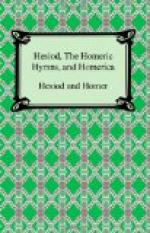Fragment #2 —
Plutarch Mor. 1034 E:
`Decide no suit until you have heard both sides speak.’
Fragment #3 — Plutarch de Orac. defectu ii. 415 C: `A chattering crow lives out nine generations of aged men, but a stag’s life is four times a crow’s, and a raven’s life makes three stags old, while the phoenix outlives nine ravens, but we, the rich-haired Nymphs, daughters of Zeus the aegis-holder, outlive ten phoenixes.’
Fragment #4 — Quintilian, i. 15: Some consider that children under the age of seven should not receive a literary education... That Hesiod was of this opinion very many writers affirm who were earlier than the critic Aristophanes; for he was the first to reject the “Precepts”, in which book this maxim occurs, as a work of that poet.
THE GREAT WORKS (fragments)
Fragment #1 — Comm. on Aristotle, Nicomachean Ethics. v. 8: The verse, however (the slaying of Rhadamanthys), is in Hesiod in the “Great Works” and is as follows: `If a man sow evil, he shall reap evil increase; if men do to him as he has done, it will be true justice.’
Fragment #2 — Proclus on Hesiod, Works and Days, 126: Some believe that the Silver Race (is to be attributed to) the earth, declaring that in the “Great Works” Hesiod makes silver to be of the family of Earth.
THE IDAEAN DACTYLS (fragments)
Fragment #1 —
Pliny, Natural History vii. 56, 197:
Hesiod says that those who are called the Idaean Dactyls
taught
the smelting and tempering of iron in Crete.
Fragment #2 —
Clement, Stromateis i. 16. 75:
Celmis, again, and Damnameneus, the first of the Idaean
Dactyls,
discovered iron in Cyprus; but bronze smelting was
discovered by
Delas, another Idaean, though Hesiod calls him Scythes
(1).
ENDNOTES:
(1) Or perhaps `a Scythian’.
THE THEOGONY (1,041 lines)
(ll. 1-25) From the Heliconian Muses let us begin to sing, who hold the great and holy mount of Helicon, and dance on soft feet about the deep-blue spring and the altar of the almighty son of Cronos, and, when they have washed their tender bodies in Permessus or in the Horse’s Spring or Olmeius, make their fair, lovely dances upon highest Helicon and move with vigorous feet. Thence they arise and go abroad by night, veiled in thick mist, and utter their song with lovely voice, praising Zeus the aegis-holder and queenly Hera of Argos who walks on golden sandals and the daughter of Zeus the aegis-holder bright-eyed Athene, and Phoebus Apollo, and Artemis who delights in arrows, and Poseidon the earth-holder who shakes the earth, and reverend Themis and quick-glancing (1) Aphrodite, and Hebe with the crown of gold, and fair Dione, Leto, Iapetus, and Cronos the crafty counsellor, Eos and great Helius and bright Selene, Earth too, and great Oceanus, and dark Night, and the holy race of all the other deathless ones that are for ever. And one day they taught Hesiod glorious song while he was shepherding his lambs under holy Helicon, and this word first the goddesses said to me — the Muses of Olympus, daughters of Zeus who holds the aegis:




